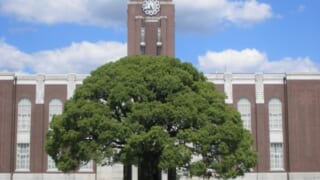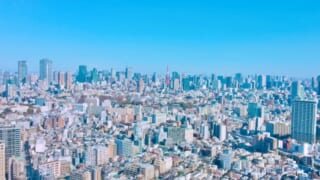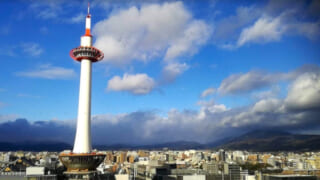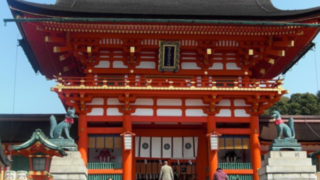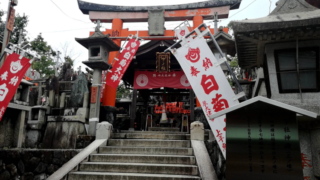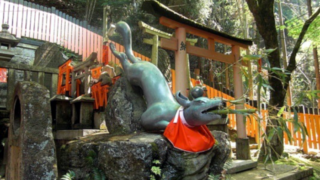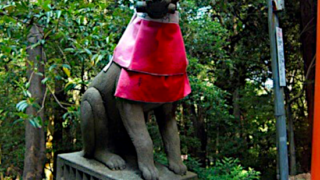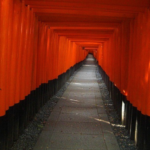As July begins, Kyoto City is in the latter half of its rainy season. The city center is usually bustling with tourists, but during the rainy season (late June to early July) and the cold month of February, the number of tourists tends to be relatively low.
After all, you can’t go sightseeing when it’s constantly raining during the rainy season. (Although the number of people increases again when the Gion Festival gets into full swing…)
Now, this time I would like to introduce “Fushimi Inari Taisha,” which is very popular with foreign tourists.
Fushimi Inari is actually very vast, and the number of shrines built on the entire Mt. Inari is astronomical. The vibrant Romon Gate, the main shrine, and the Senbon Torii gates that you often see and imagine from news and so on are only a small part of the bustling Inari Shrine at the foot of Mt. Inari.
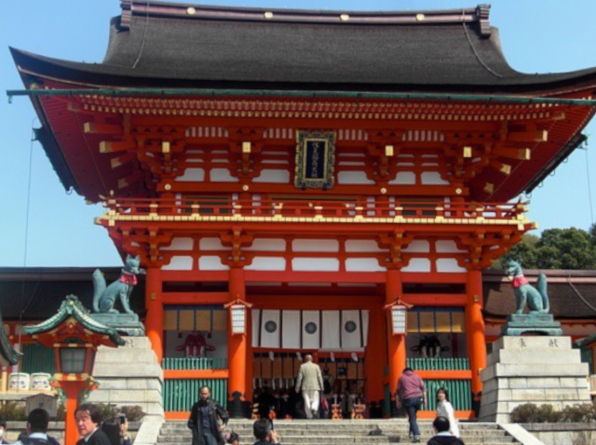
However, the real Fushimi Inari lies beyond.
The vast Mt. Inari stretches beyond the Senbon Torii and Okunoin. The “O-yama Meguri” (mountain pilgrimage) of Mt. Inari is a 4km round trip. When you complete it, you will surely be a different person than the one who passed through the first torii gate. The image of Fushimi Inari you had until then will probably be completely gone.
From casual tourists to deep Inari believers, “Fushimi Inari” is and has always been extremely popular.
Here, I will introduce Fushimi Inari with photos over several installments, but as the saying goes, “seeing is believing.” Please visit the site to experience the boundless power of Fushimi Inari for yourself.
Note: This article is a revised version based on an article written in 2013. The photos used include those from 2013.
- Introduction
- Outline of Fushimi Inari Taisha
- JR “Inari” Station and Keihan “Fushimi Inari” Station
- First Torii Gate
- The First Torii Gate and Vermilion
- Reikonsha, Fujiosha, Kumanosha
- Main Approach and Sanshuden
- Romon Gate
- Left and Right Ministers of the Romon Gate
- Outer Haiden (Hall of Worship)
- Inner Haiden (Hall of Worship)
- Main Shrine
- Gonden (Provisional Main Shrine)
- Former Residence of Kada no Azumamaro
- Higashimaru Shrine
Introduction
In Japan, there are said to be “eight million gods (Yaoyorozu no Kami),” and there are said to be about 90,000 “shrines” of all sizes that enshrine them. Of these, about 30,000 are said to be “Inari Shrines.” The head shrine of these Inari Shrines that are spread throughout Japan is “Fushimi Inari Taisha.” I’m sure there’s an “Oinari-san” or “Inari Shrine” in your neighborhood, isn’t there?
The gods enshrined at Fushimi Inari Taisha are the gods of bountiful harvests, business prosperity, and industrial development, but they are also said to bring blessings for household safety, traffic safety, and improvement in performing arts.
The origin of Fushimi Inari began as a deity of the “Hata clan” who ruled this region before the Heian capital was moved, but after the Heian period, it became a shrine that enjoyed immense popularity among everyone from the emperor to the nobility and common people, and even today, it is known for its large number of foreign tourists and visitors for Hatsumode (first shrine visit of the New Year).
Why did Fushimi Inari Taisha become such a popular shrine? Why did so many shrines come to be lined up? What is the relationship between the many enshrined gods?
To answer these questions, I would like to make a pilgrimage around Mt. Inari, which has a landscape rare in the world.
Outline of Fushimi Inari Taisha
Fushimi Inari Taisha is the head shrine of Inari shrines located in Fukakusa, Fushimi Ward, Kyoto City, as mentioned above.
The Inari Okami, commonly known as “O-inari-san,” is enshrined at the foot of Mt. Inari, which is at the southern end of Kyoto’s 36 Higashiyama peaks. Mt. Inari was formerly written as “Inariyama.” In ancient times, the area around Fukakusa was a wetland, but local powerful clans took the lead in promoting rice cultivation. It is said that “Inari” (稲荷) came from “Inenari” (稲生り), which means “rice growing.” In other words, the roots of Inari Taisha are in the shrine that enshrined the native and agricultural gods of the powerful clans who ruled this land.
These clans are varied in different texts, such as the Hata clan, the Kamo clan, and the Kada clan, but all of their shrines can be seen on Mt. Inari.
The beginning of Fushimi Inari is generally said to be when the Hata clan built a shrine on Inari Sankamine (near the summit of Mt. Inari), where the three Inari gods, including “Ukanomitama no Okami,” are said to have descended.
After that, the main shrine was relocated to its current position, but the three peaks came to be worshiped as “sacred sites.”
Inari believers aim for the summit of Mt. Inari, which is 233m above sea level, to receive blessings. Making a circuit of these sacred sites on Mt. Inari is called “O-yama Meguri.” Today, it is like a trail or a climb, but in the past, the footing was a bit worse, so it might have been more like a “training.”
This time, I would like to walk the “O-yama Meguri,” which has been practiced since the Heian period, starting from JR “Inari” Station.
The map below is a guide to the entire Mt. Inari. The area centered around the “Main Shrine” at the bottom of the map is the narrow-sense “Fushimi Inari Taisha.” The other “〇〇 Shrine” are representative related shrines.
There are also subordinate and auxiliary shrines of “Fushimi Inari Taisha,” and as will be mentioned later, there are also completely unrelated shrines.
Mt. Inari is also a theme park of these kinds of shrines.

Now let’s get started.
In the first installment, I will introduce the area around the Fushimi Inari Taisha main shrine, starting from the nearest station, JR Inari Station, and entering from the first torii gate.
JR “Inari” Station and Keihan “Fushimi Inari” Station
When accessing Fushimi Inari by train, you can use JR Inari Station or Keihan’s Fushimi Inari Station. If you are coming from Kyoto Station, you can take the JR Nara Line and you will arrive in two stops from Kyoto Station. It takes 5 minutes one way, and the fare is 140 yen.
This is JR “Inari Station.” It is located directly in front of the main approach, and as soon as you cross the street, you will find the first torii gate.
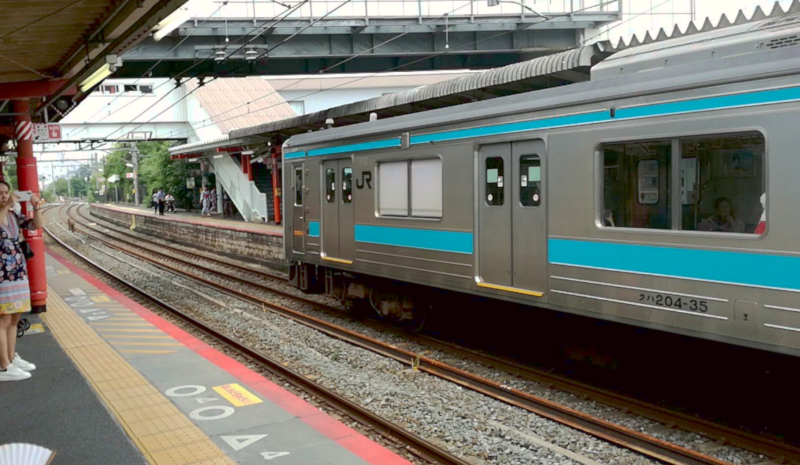
By the way, there is a convenience store next to the station, so it’s a good idea to stock up on food and drinks here. Once you enter Mt. Inari, bottled tea and other items will have “mountain prices” and will be more expensive.

The photo below is Keihan “Fushimi Inari” Station. It is located at the end of another approach, the Shinko-do. If you are coming from the Osaka area, you can take the limited express from Kyobashi to Tambabashi, and then transfer and arrive in 4 stops.

There is not just one entrance to Fushimi Inari Taisha. If you use Keihan Fushimi Inari Station, you will approach from the Shinko-do (north approach), which is one street north.
If you are coming by car, there is a parking lot entrance on the immediate right (south) of the first torii gate. However, Fushimi Kaido (Honmachi-dori) is a one-way street from south to north, so if you are coming from the north, you need to go south on Shidan Kaido or National Route 24, go east on Daiichi Gundo in front of Ryukoku University, and then go north on Honmachi-dori.

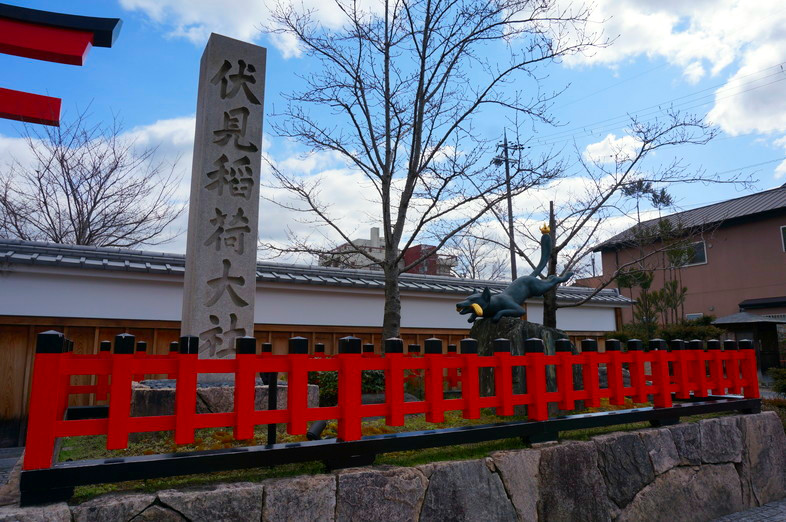
First Torii Gate
When you get off at JR Inari Station, you will see a large vermilion torii gate in front of you. This is the “first torii gate,” the main entrance to Fushimi Inari Taisha. It faces Fushimi Kaido (Honmachi-dori).
As mentioned earlier, a tour around Mt. Inari, where Fushimi Inari Taisha is located, is called “O-yama Meguri,” and this is the starting point of the “O-yama Meguri.”
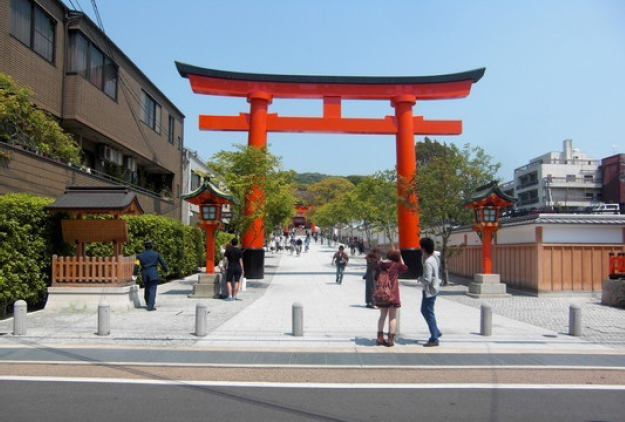
The photo above is from 6 years ago, in June 2013. At that time, my impression was that there were not so many foreign tourists.

And this is the first torii gate in July 2019. Even though it was the rainy season and I thought there would be fewer people, it was already overflowing with people at 9 a.m.
Lately, there have been especially many tourists from Asia, and conversely, fewer Japanese people. The clientele has changed dramatically in the last few years.
From here on, I will be using a mix of photos from 2013 and 2019. For parts that have undergone little change over the years, I have used the better-quality photos from 2013.
The First Torii Gate and Vermilion
The photo below shows the first torii gate seen from the approach.
The torii gates at Inari Shrines nationwide and at Fushimi Inari Taisha are called “Inari Torii,” and they have a circular ring called a “daiwa” between the two pillars and the shimagi at the top, and the bottom of the pillars are wrapped in black-painted wood.
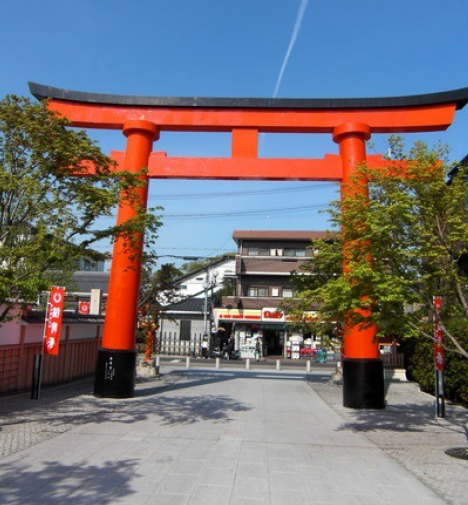
Most of the torii gates at Fushimi Inari are dyed in its symbolic vermilion color. Vermilion is said to be a color that symbolizes “life” and “dynamism,” and is believed to ward off evil spirits and attract happiness.
Most of the torii gates are made of “cedar,” and many shrines within Fushimi Inari also enshrine “cedar” as a sacred object.
The surface of the torii gates is coated multiple times with “komyotan,” a pigment made by dissolving tan (mercury) in oil, to prevent insects and decay. Once a torii gate is made and dedicated, it is said to last for 20 years, and it continues to stand on Mt. Inari as a testament to people’s faith.
The photo below is from 2019, and the sign for the “Daily Yamazaki” convenience store has been changed to Kyoto colors. This is part of the Kyoto City Landscape Ordinance.
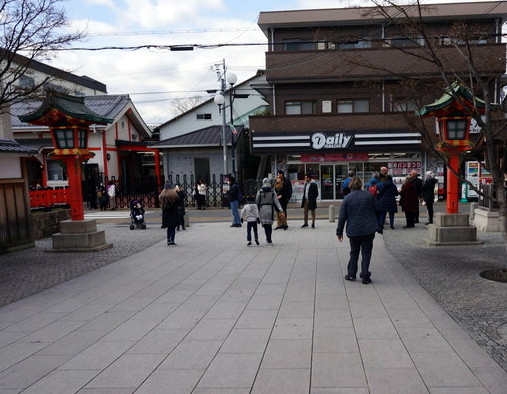
Reikonsha, Fujiosha, Kumanosha
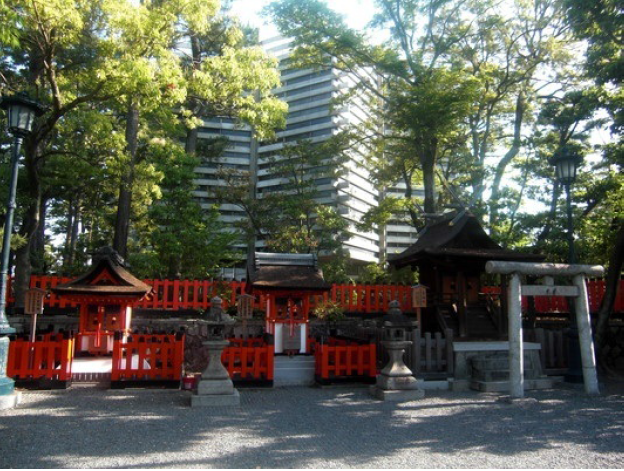
Fushimi Inari has many large and small auxiliary shrines.
There are also auxiliary shrines between the main approach and the Romon Gate, which are “Reikonsha,” “Fujiosha,” and “Kumanosha” from the right.
“Fujiosha” and “Kumanosha” are said to be gods that were enshrined in this area even before Fushimi Inari Taisha.
The building in the back is the “Gishikiden” (built in 1968), a hall of Fushimi Inari Taisha in the shape of an eight-pointed star.
*The Gishikiden was demolished in 2024 due to aging.
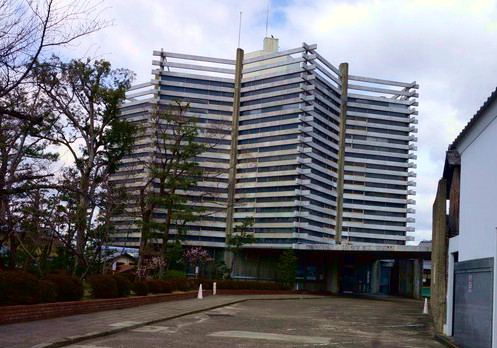
Main Approach and Sanshuden
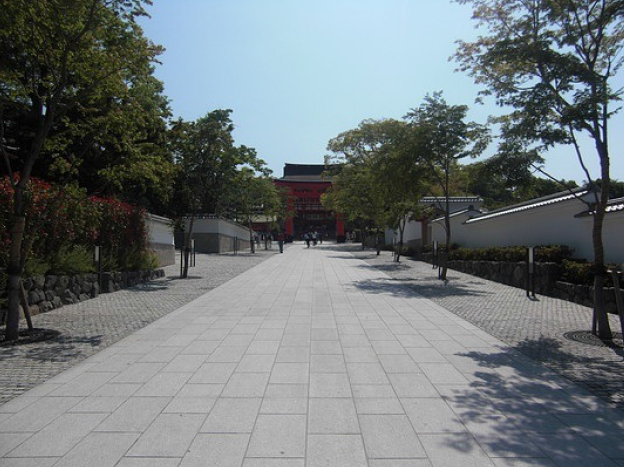
From the first torii gate to the second torii gate, a stone pavement continues. In the back, you can see the second torii gate and the Romon Gate.
Previously, you could drive from the main approach to the parking lot in front of the Sanshuden, but a road exclusively for cars has now been built on the south side.
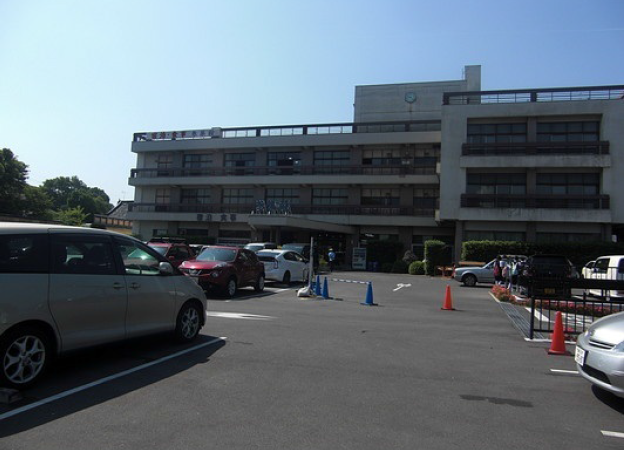
The photo above is the Sanshuden. It is the accommodation facility of Fushimi Inari Taisha. It also holds events and has a rest area and a cafeteria.
*The Sanshuden was demolished in 2020 due to aging.
Romon Gate

As you proceed down the main approach, you will see the large main gate of Fushimi Inari.
This two-story, irimoya-style Romon Gate has a cypress bark roof and a striking vermilion color.
This Romon Gate was built by Toyotomi Hideyoshi in 1589 (Tensho 17).
Hideyoshi, who had unified the country, built Fushimi Castle in the present-day Momoyama area, south of Fushimi Inari, and its castle town flourished greatly.
As Fushimi Castle and Fushimi Inari are close to each other, Hideyoshi deepened his faith in Inari and prayed for the recovery of his mother, Omandokoro, who was seriously ill, promising to donate 10,000 koku if she recovered.
As a result of the prayers, Omandokoro recovered, and Hideyoshi’s donation led to the full-scale repair of the shrine buildings, including the Romon Gate, which was built at that time. It was later repaired in 1974 (Showa 49) and 2010 (Heisei 22). The pair of fox statues in front of the Romon Gate hold the sacred jewels and keys of the enshrined deity.
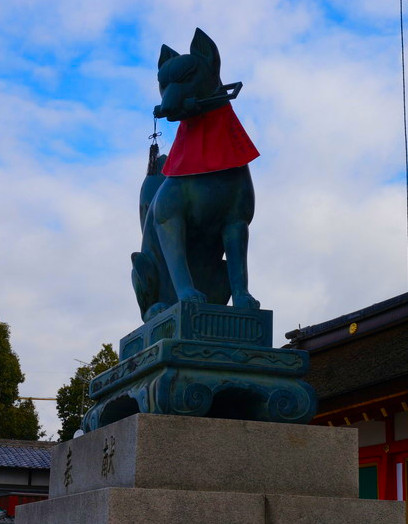
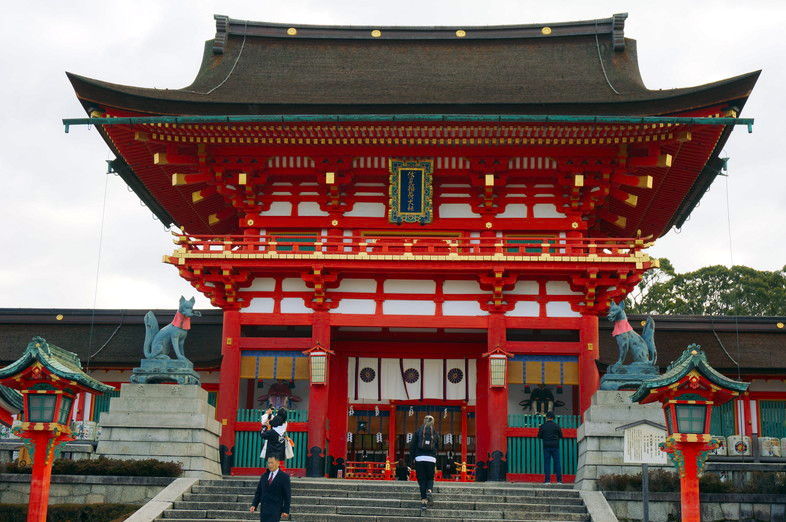
Left and Right Ministers of the Romon Gate
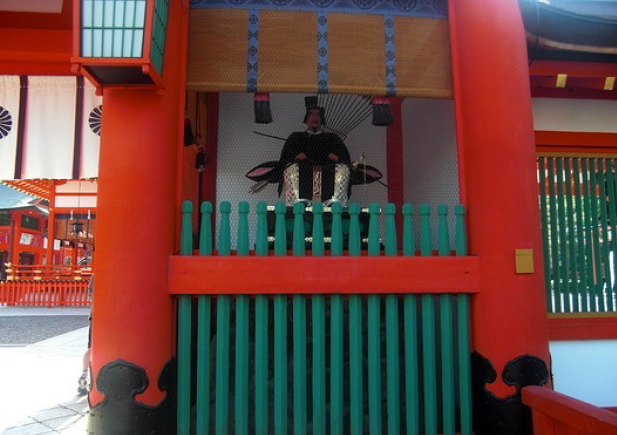
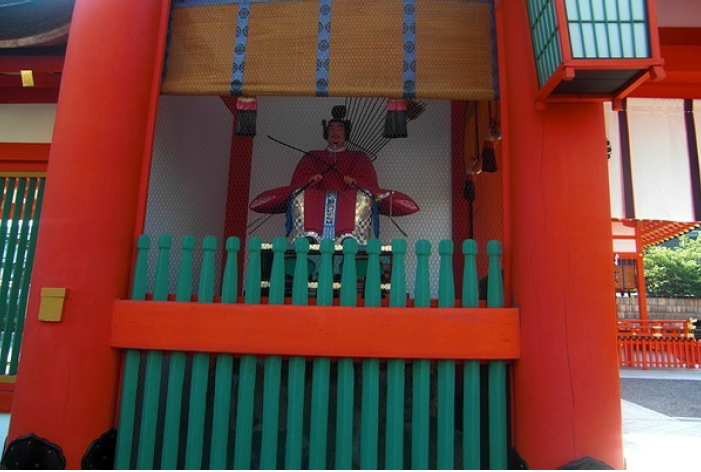
While large temple gates are guarded by a pair of Agyo and Ungyo Nio statues, shrine gates are guarded by a pair of Agyo and Ungyo ministers.
On the right side facing the gate is the Agyo (open-mouthed) Left Minister (top photo), and on the left side is the Ungyo (closed-mouthed) Right Minister. They are also called the “Arrow Ministers” (bottom photo).
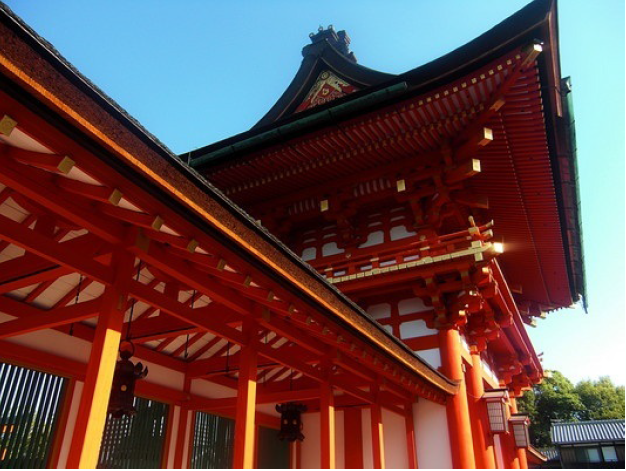
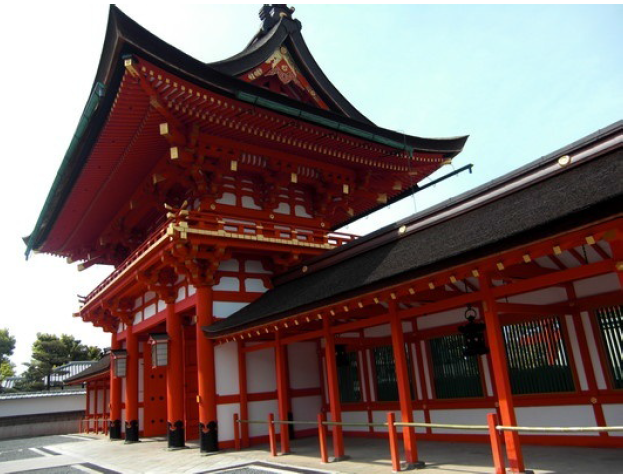
This is the Romon Gate viewed from inside the shrine grounds. The powerful vermilion gate, which incorporates the Momoyama style, is one of Kyoto’s most prominent Romon Gates.
Outer Haiden (Hall of Worship)
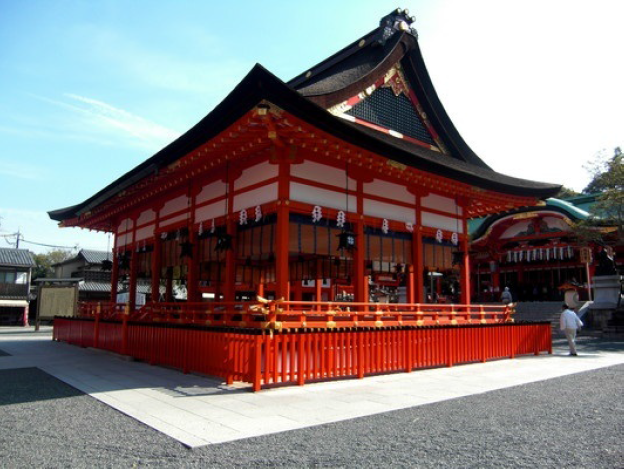
When you pass through the Romon Gate, you will see the Outer Haiden in front of you.
Fushimi Inari Taisha has two halls of worship, the Inner Haiden and the Outer Haiden.
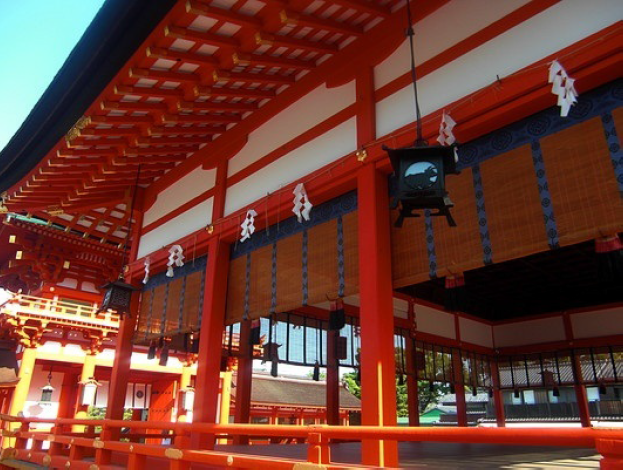
The Inner Haiden is used for general worship, while the Outer Haiden is used for the Setsubun Festival in February, where beans are scattered from here.
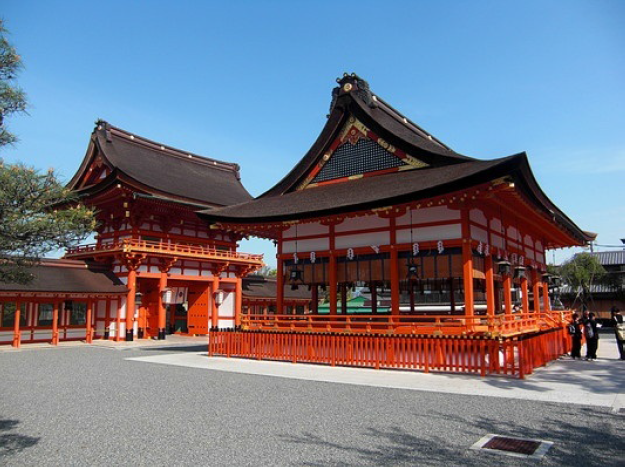
The Romon Gate and the Outer Haiden. The Outer Haiden is also said to have been built by Hideyoshi at the same time as the Romon Gate.
Inner Haiden (Hall of Worship)
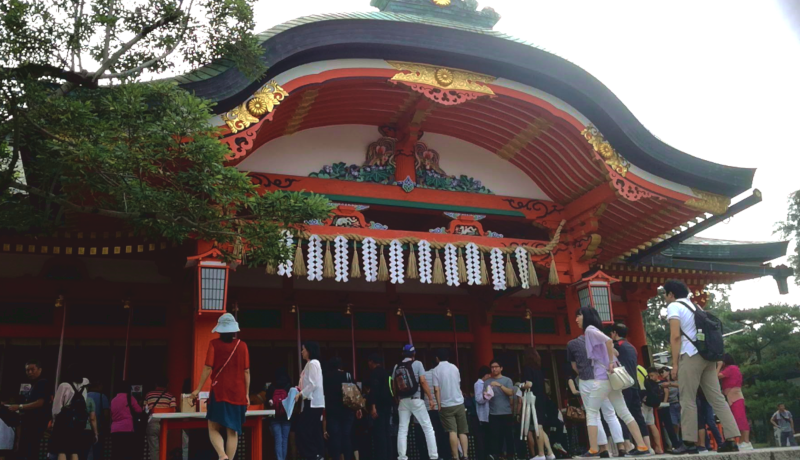
This is the Inner Haiden.
It is said to have been built in 1694 (Genroku 7).
It is characterized by a large vermilion kara-hafu (undulating roof gable) which was attached to the Inner Haiden in 1961 (Showa 36). A similar kara-hafu is also used in the shrine building of Gokonomiya Shrine in Momoyama Otesuji, also in Fushimi Ward. This is the reason why the highly colorful kara-hafu, which Hideyoshi loved, is referred to as the Momoyama style.
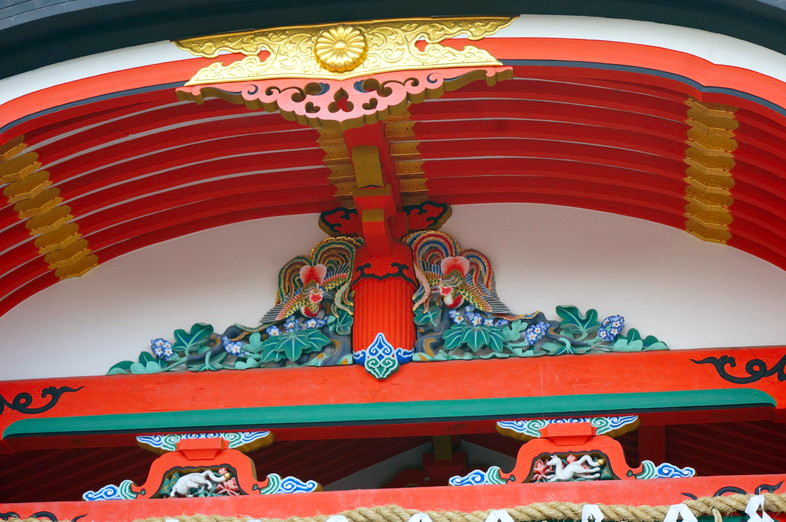
A pair of komagitsune (fox statues) are placed on both sides of the stone steps leading to the Haiden.
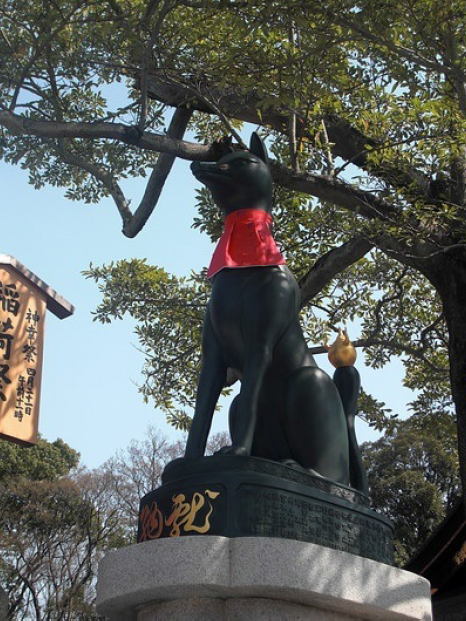
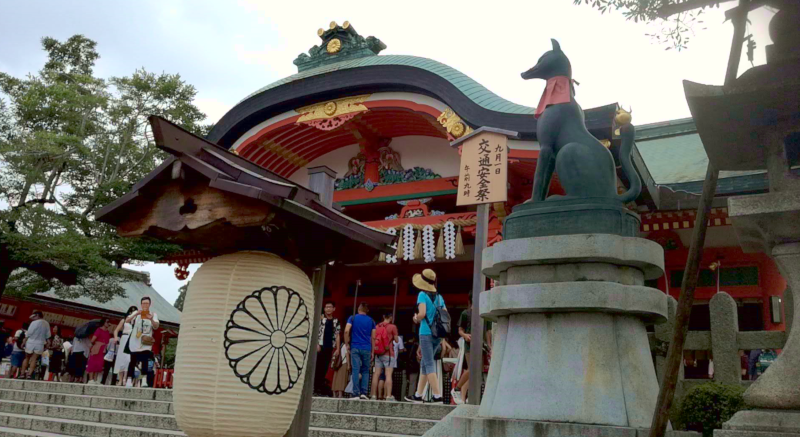
If you look closely, you can see the chrysanthemum crest. This suggests a connection with the Imperial Family. As we will see in later installments, there are many shrines on Mt. Inari that have the chrysanthemum crest. For example, Shiragiku Okami is another name for the main enshrined deity here, which hints at a connection to Ise Grand Shrine.
Main Shrine
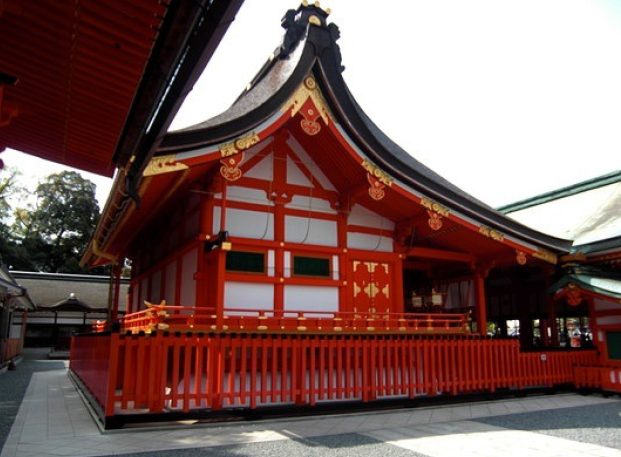
The main shrine is a hiyada-buki (cypress bark roof) shrine that was rebuilt in 1499 (Meio 8) after being destroyed in the Onin War and is designated as an Important Cultural Property.
The main shrine is a nagare-zukuri style with five one-bay shrines arranged horizontally to enshrine the five deities. For this reason, the shrine building is wide, and the nagare-zukuri roof is not symmetrical on the front and back, with the front extending considerably longer than the back.
The enshrined deities are the three deities of Kami-no-sha, Naka-no-sha, and Shimo-no-sha, and the two deities of Tanaka-sha and Ohyashima-sha. They are enshrined in the following order from the left (north).
| Northernmost Seat | Tanaka no Okami | tanaka no okami | Gongorofu Okami, Tanaka-sha |
| North Seat | Satahiko no Okami | satahiko no okami | Aoki Okami, Naka-no-sha |
| Central Seat | Ukanomitama no Okami | ukanomitama no okami | Shiragiku Okami, Shimo-no-sha |
| South Seat | Omiyame no Okami | omiyame no okami | Suehiro Okami, Kami-no-sha |
| Southernmost Seat | Shinokami | shi no okami | Ohyashima Okami, Ohyashima-sha |
*There are theories that Shinokami refers to four different deities, and other theories that it refers to one deity.
The far-right column of the table lists the alternative names of the deities, and shrines where these deities are enshrined are scattered throughout Mt. Inari. A journey to visit these “sacred sites” is the “O-yama Meguri.”
The five deities mentioned above are collectively called the Inari gods. None of them is the main enshrined deity, and all five are equal. Therefore, as mentioned above, the shrine building is divided into five sections as an aiden (auxiliary hall). In addition, there are five portable shrines used in festivals, and during the Ujiko (parishioner) Festival held as part of the Inari Festival, parishioners from each of the five districts carry their respective portable shrines to liven up the festival.
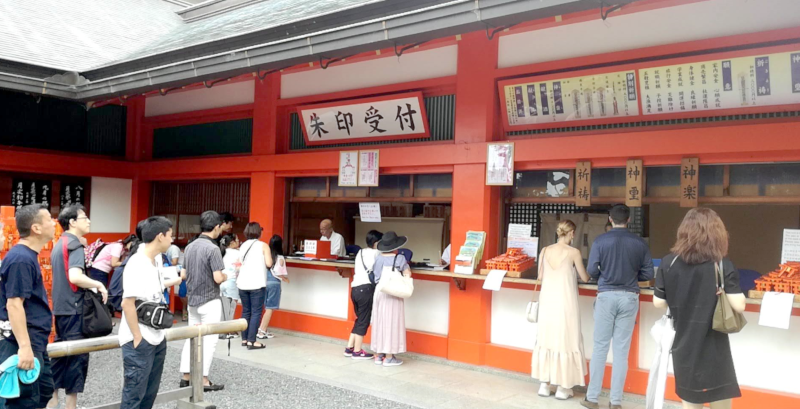
Next to the main shrine, there is a reception desk for goshuin (red stamps) and a sales counter for omamori (charms), etc.
Gonden (Provisional Main Shrine)
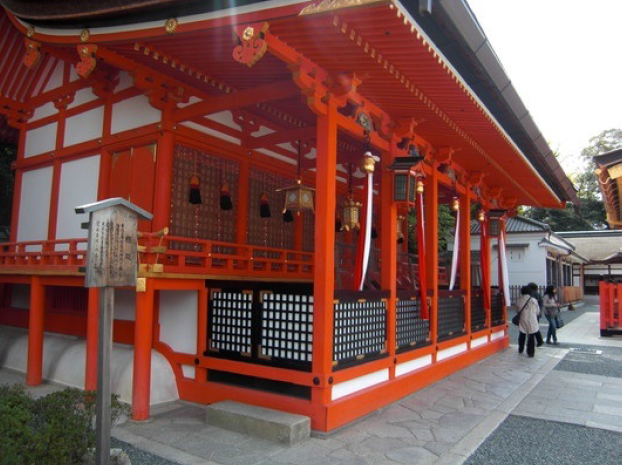
This is an aiden (auxiliary hall) for the same five deities as the main shrine, and it is used as a temporary palace when the main shrine is being renovated. For this reason, it is sometimes called “Karido” (temporary palace) instead of “Gonden,” and it is also referred to as Senden or Wakamiya.
Former Residence of Kada no Azumamaro
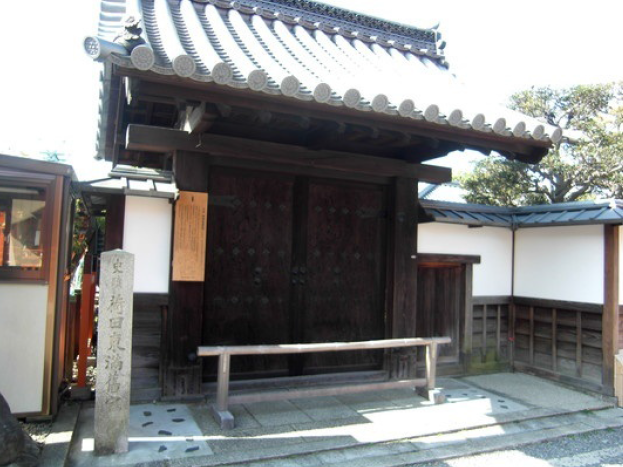
To the south of the Outer Haiden and Romon Gate is the “Former Residence of Kada no Azumamaro.”
Kada no Azumamaro (1669-1736) was born into the Kada family of Fushimi Inari priests. However, he did not inherit the priesthood and instead devoted himself to the study of classical literature, and he came to be counted as one of the Four Great Men of Kokugaku (national learning), along with Kamo no Mabuchi, Motoori Norinaga, and Hirata Atsutane. His former residence is now a nationally designated historical site called the “Former Residence of Kada no Azumamaro.” By the way, near the summit of Mt. Inari, between Ni-no-mine and San-no-mine, there is the Kadasha, which enshrines the ancestral gods of the Kada family.
Higashimaru Shrine
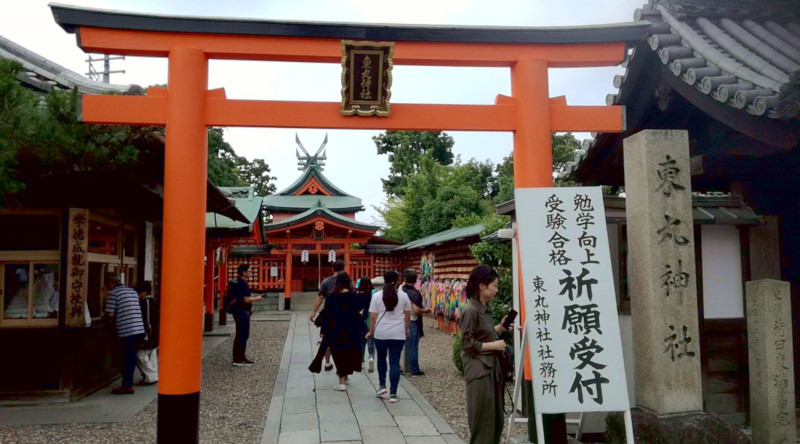
Adjacent to the “Former Residence of Kada no Azumamaro” is Higashimaru Shrine.
Higashimaru Shrine was founded in 1883 (Meiji 16) by the chief priests of Fushimi Inari Taisha who raised donations.
Many people visit here to pray for academic improvement and success in exams, hoping to receive blessings like Kada no Azumamaro.
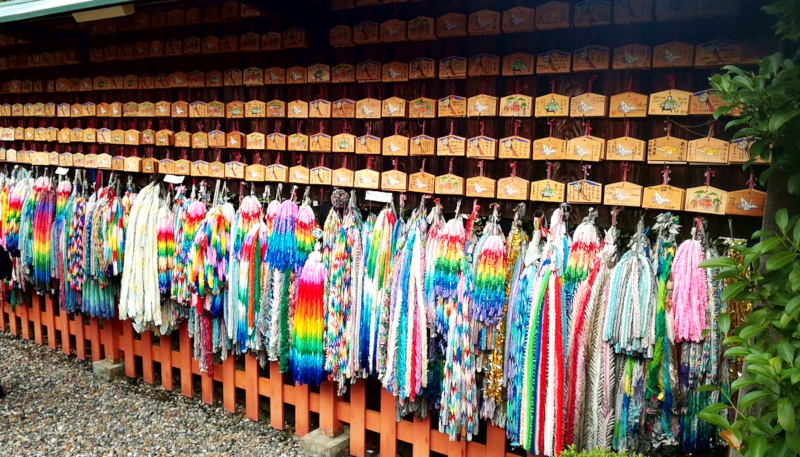
The ema (votive plaques) and senbazuru (thousand paper cranes) are neatly and regularly arranged. I’m sure they will bring good fortune. You can feel the persistence of the prayers for success in the exams.
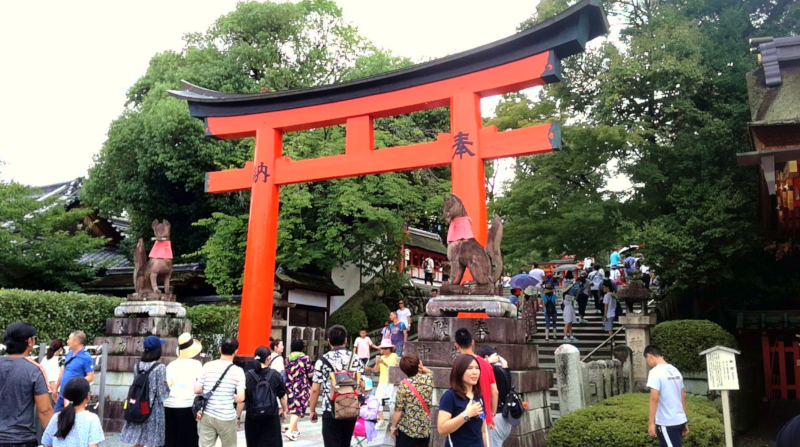
This concludes the introduction of the Fushimi Inari Taisha grounds.
When you pass through this torii gate behind the main shrine, you leave the main grounds and continue toward the “Senbon Torii”(thousand gate).
Some people just visit the main shrine and leave, but most tourists seem to visit the “Senbon Torii” as well before they go home.
This is the end of the first installment. To be continued in the next part.
